7204ENG - Risk Management Report: ABC Pvt Ltd Lean Production Project
VerifiedAdded on 2023/06/08
|46
|14654
|484
Report
AI Summary
This report provides a comprehensive risk analysis and management strategy for ABC Pvt Ltd, a manufacturing company implementing lean production for gearboxes. It covers risk identification, assessment, response planning, and implementation, addressing potential challenges in the new process and ensuring minimal disruption to existing production. The report also details the risk tracking, monitoring, and control system, alongside a real-life incident example, offering insights into effective risk mitigation. The analysis considers the company's stakeholders, contract type (Design Bid Build), and potential risks associated with the transition to lean production.
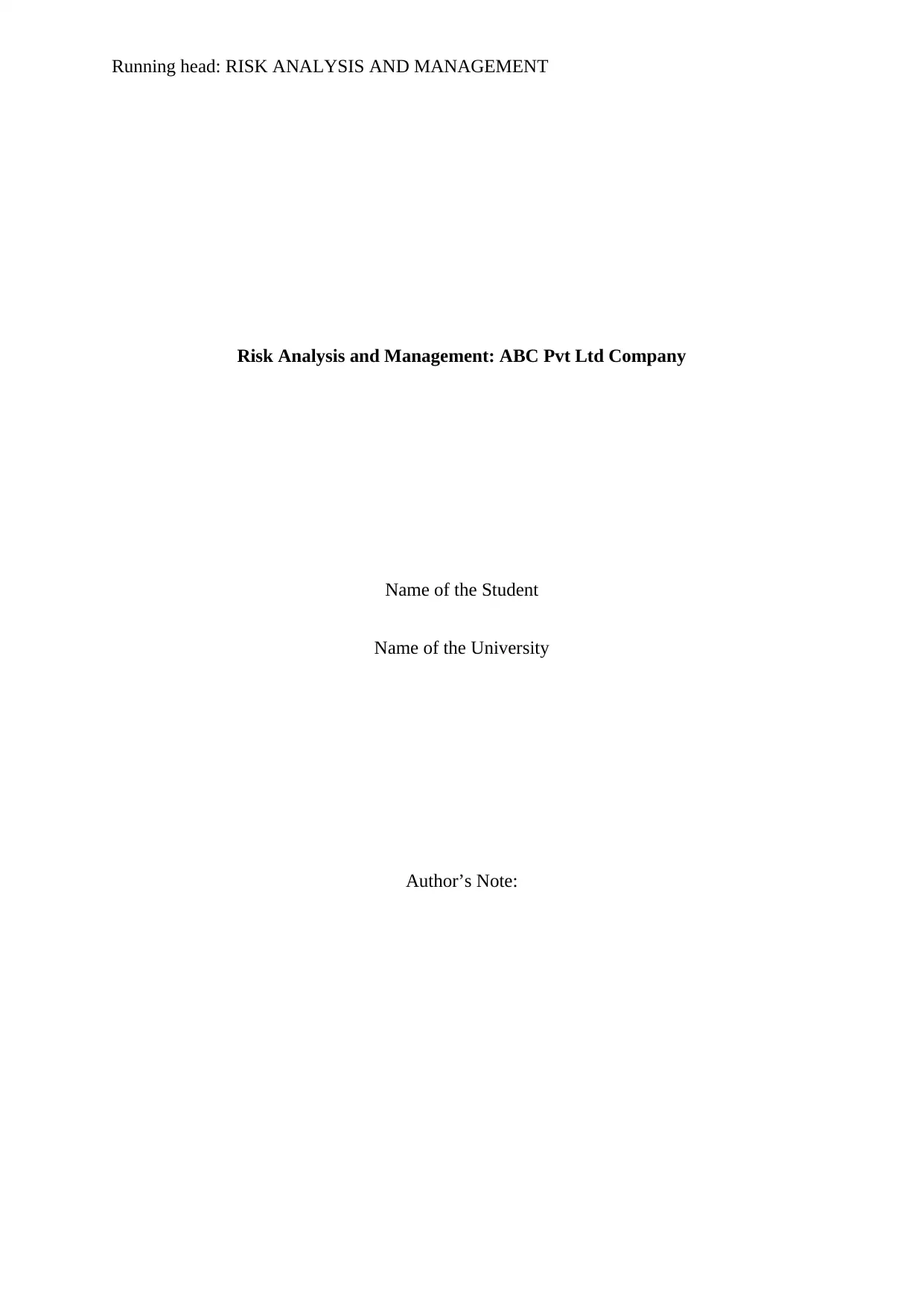
Running head: RISK ANALYSIS AND MANAGEMENT
Risk Analysis and Management: ABC Pvt Ltd Company
Name of the Student
Name of the University
Author’s Note:
Risk Analysis and Management: ABC Pvt Ltd Company
Name of the Student
Name of the University
Author’s Note:
Paraphrase This Document
Need a fresh take? Get an instant paraphrase of this document with our AI Paraphraser
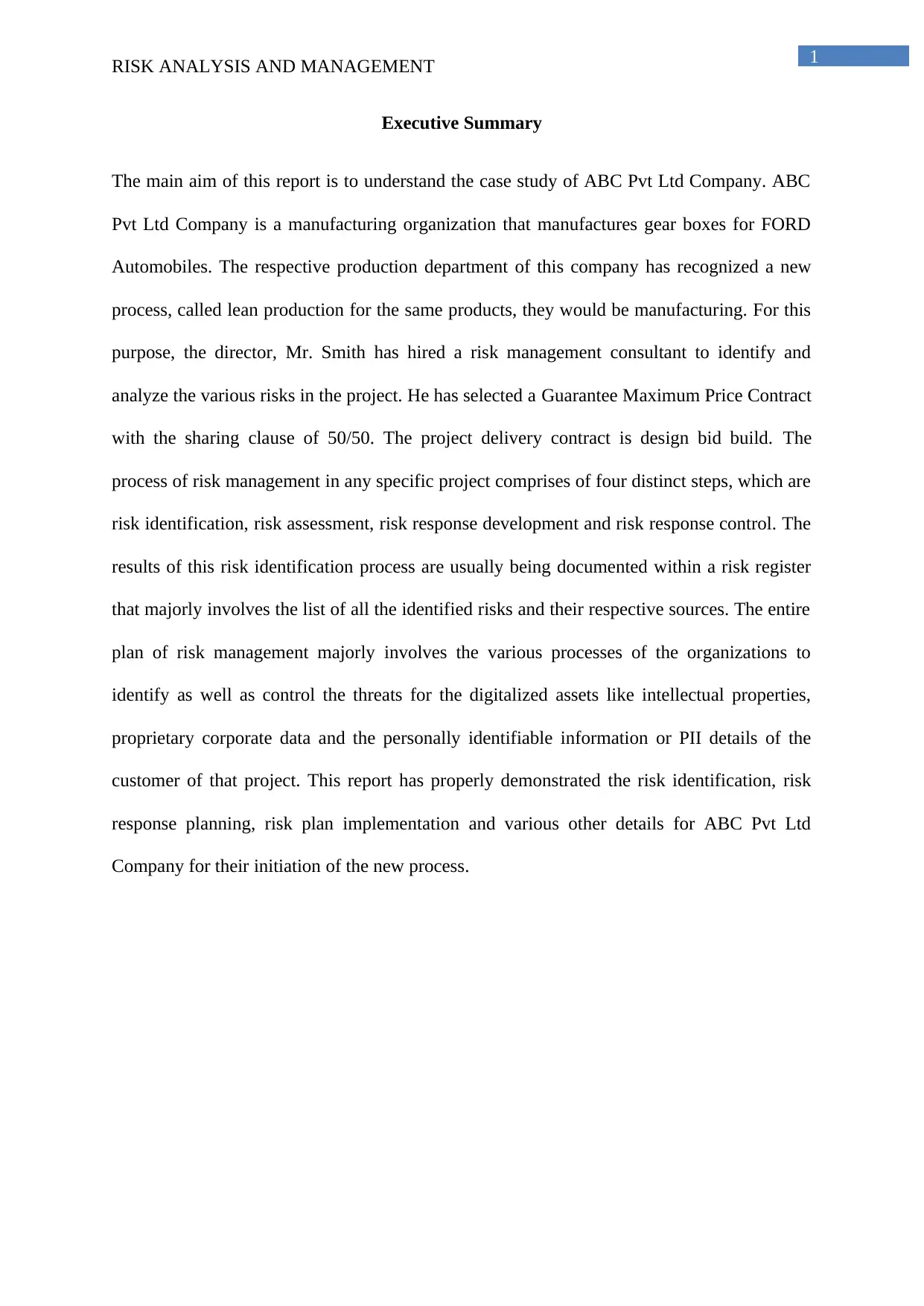
1
RISK ANALYSIS AND MANAGEMENT
Executive Summary
The main aim of this report is to understand the case study of ABC Pvt Ltd Company. ABC
Pvt Ltd Company is a manufacturing organization that manufactures gear boxes for FORD
Automobiles. The respective production department of this company has recognized a new
process, called lean production for the same products, they would be manufacturing. For this
purpose, the director, Mr. Smith has hired a risk management consultant to identify and
analyze the various risks in the project. He has selected a Guarantee Maximum Price Contract
with the sharing clause of 50/50. The project delivery contract is design bid build. The
process of risk management in any specific project comprises of four distinct steps, which are
risk identification, risk assessment, risk response development and risk response control. The
results of this risk identification process are usually being documented within a risk register
that majorly involves the list of all the identified risks and their respective sources. The entire
plan of risk management majorly involves the various processes of the organizations to
identify as well as control the threats for the digitalized assets like intellectual properties,
proprietary corporate data and the personally identifiable information or PII details of the
customer of that project. This report has properly demonstrated the risk identification, risk
response planning, risk plan implementation and various other details for ABC Pvt Ltd
Company for their initiation of the new process.
RISK ANALYSIS AND MANAGEMENT
Executive Summary
The main aim of this report is to understand the case study of ABC Pvt Ltd Company. ABC
Pvt Ltd Company is a manufacturing organization that manufactures gear boxes for FORD
Automobiles. The respective production department of this company has recognized a new
process, called lean production for the same products, they would be manufacturing. For this
purpose, the director, Mr. Smith has hired a risk management consultant to identify and
analyze the various risks in the project. He has selected a Guarantee Maximum Price Contract
with the sharing clause of 50/50. The project delivery contract is design bid build. The
process of risk management in any specific project comprises of four distinct steps, which are
risk identification, risk assessment, risk response development and risk response control. The
results of this risk identification process are usually being documented within a risk register
that majorly involves the list of all the identified risks and their respective sources. The entire
plan of risk management majorly involves the various processes of the organizations to
identify as well as control the threats for the digitalized assets like intellectual properties,
proprietary corporate data and the personally identifiable information or PII details of the
customer of that project. This report has properly demonstrated the risk identification, risk
response planning, risk plan implementation and various other details for ABC Pvt Ltd
Company for their initiation of the new process.
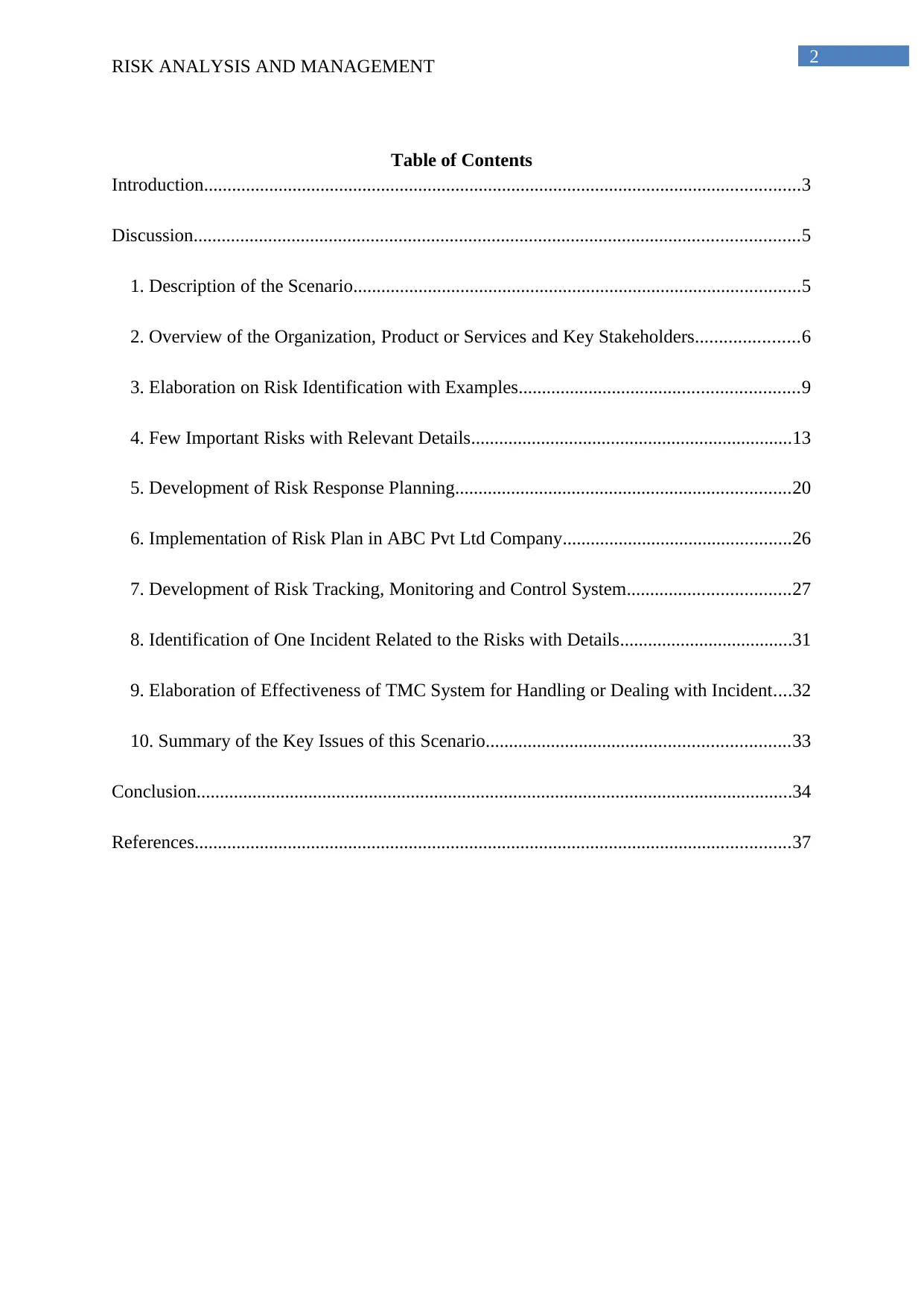
2
RISK ANALYSIS AND MANAGEMENT
Table of Contents
Introduction................................................................................................................................3
Discussion..................................................................................................................................5
1. Description of the Scenario................................................................................................5
2. Overview of the Organization, Product or Services and Key Stakeholders......................6
3. Elaboration on Risk Identification with Examples............................................................9
4. Few Important Risks with Relevant Details.....................................................................13
5. Development of Risk Response Planning........................................................................20
6. Implementation of Risk Plan in ABC Pvt Ltd Company.................................................26
7. Development of Risk Tracking, Monitoring and Control System...................................27
8. Identification of One Incident Related to the Risks with Details.....................................31
9. Elaboration of Effectiveness of TMC System for Handling or Dealing with Incident....32
10. Summary of the Key Issues of this Scenario.................................................................33
Conclusion................................................................................................................................34
References................................................................................................................................37
RISK ANALYSIS AND MANAGEMENT
Table of Contents
Introduction................................................................................................................................3
Discussion..................................................................................................................................5
1. Description of the Scenario................................................................................................5
2. Overview of the Organization, Product or Services and Key Stakeholders......................6
3. Elaboration on Risk Identification with Examples............................................................9
4. Few Important Risks with Relevant Details.....................................................................13
5. Development of Risk Response Planning........................................................................20
6. Implementation of Risk Plan in ABC Pvt Ltd Company.................................................26
7. Development of Risk Tracking, Monitoring and Control System...................................27
8. Identification of One Incident Related to the Risks with Details.....................................31
9. Elaboration of Effectiveness of TMC System for Handling or Dealing with Incident....32
10. Summary of the Key Issues of this Scenario.................................................................33
Conclusion................................................................................................................................34
References................................................................................................................................37
⊘ This is a preview!⊘
Do you want full access?
Subscribe today to unlock all pages.

Trusted by 1+ million students worldwide
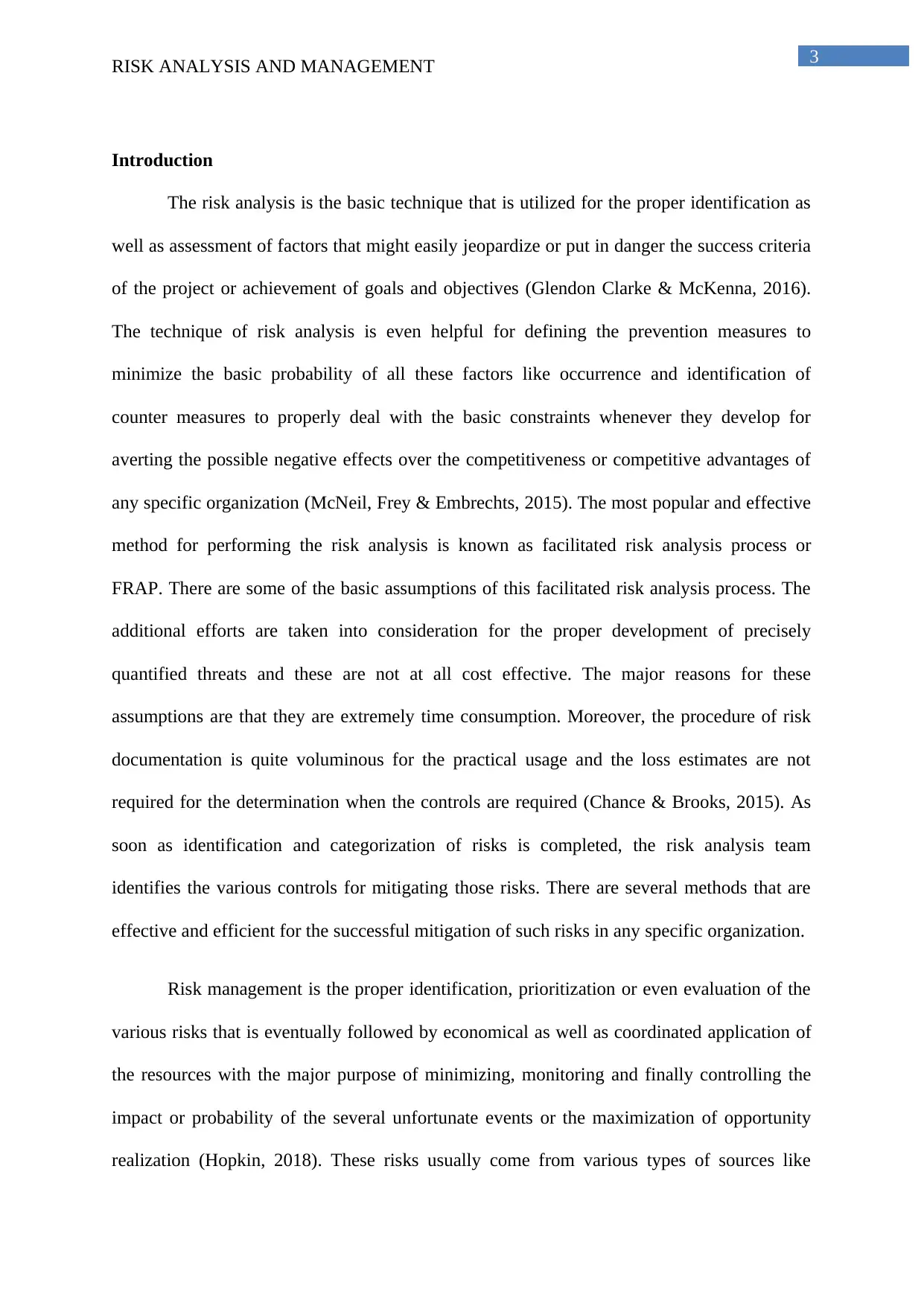
3
RISK ANALYSIS AND MANAGEMENT
Introduction
The risk analysis is the basic technique that is utilized for the proper identification as
well as assessment of factors that might easily jeopardize or put in danger the success criteria
of the project or achievement of goals and objectives (Glendon Clarke & McKenna, 2016).
The technique of risk analysis is even helpful for defining the prevention measures to
minimize the basic probability of all these factors like occurrence and identification of
counter measures to properly deal with the basic constraints whenever they develop for
averting the possible negative effects over the competitiveness or competitive advantages of
any specific organization (McNeil, Frey & Embrechts, 2015). The most popular and effective
method for performing the risk analysis is known as facilitated risk analysis process or
FRAP. There are some of the basic assumptions of this facilitated risk analysis process. The
additional efforts are taken into consideration for the proper development of precisely
quantified threats and these are not at all cost effective. The major reasons for these
assumptions are that they are extremely time consumption. Moreover, the procedure of risk
documentation is quite voluminous for the practical usage and the loss estimates are not
required for the determination when the controls are required (Chance & Brooks, 2015). As
soon as identification and categorization of risks is completed, the risk analysis team
identifies the various controls for mitigating those risks. There are several methods that are
effective and efficient for the successful mitigation of such risks in any specific organization.
Risk management is the proper identification, prioritization or even evaluation of the
various risks that is eventually followed by economical as well as coordinated application of
the resources with the major purpose of minimizing, monitoring and finally controlling the
impact or probability of the several unfortunate events or the maximization of opportunity
realization (Hopkin, 2018). These risks usually come from various types of sources like
RISK ANALYSIS AND MANAGEMENT
Introduction
The risk analysis is the basic technique that is utilized for the proper identification as
well as assessment of factors that might easily jeopardize or put in danger the success criteria
of the project or achievement of goals and objectives (Glendon Clarke & McKenna, 2016).
The technique of risk analysis is even helpful for defining the prevention measures to
minimize the basic probability of all these factors like occurrence and identification of
counter measures to properly deal with the basic constraints whenever they develop for
averting the possible negative effects over the competitiveness or competitive advantages of
any specific organization (McNeil, Frey & Embrechts, 2015). The most popular and effective
method for performing the risk analysis is known as facilitated risk analysis process or
FRAP. There are some of the basic assumptions of this facilitated risk analysis process. The
additional efforts are taken into consideration for the proper development of precisely
quantified threats and these are not at all cost effective. The major reasons for these
assumptions are that they are extremely time consumption. Moreover, the procedure of risk
documentation is quite voluminous for the practical usage and the loss estimates are not
required for the determination when the controls are required (Chance & Brooks, 2015). As
soon as identification and categorization of risks is completed, the risk analysis team
identifies the various controls for mitigating those risks. There are several methods that are
effective and efficient for the successful mitigation of such risks in any specific organization.
Risk management is the proper identification, prioritization or even evaluation of the
various risks that is eventually followed by economical as well as coordinated application of
the resources with the major purpose of minimizing, monitoring and finally controlling the
impact or probability of the several unfortunate events or the maximization of opportunity
realization (Hopkin, 2018). These risks usually come from various types of sources like
Paraphrase This Document
Need a fresh take? Get an instant paraphrase of this document with our AI Paraphraser
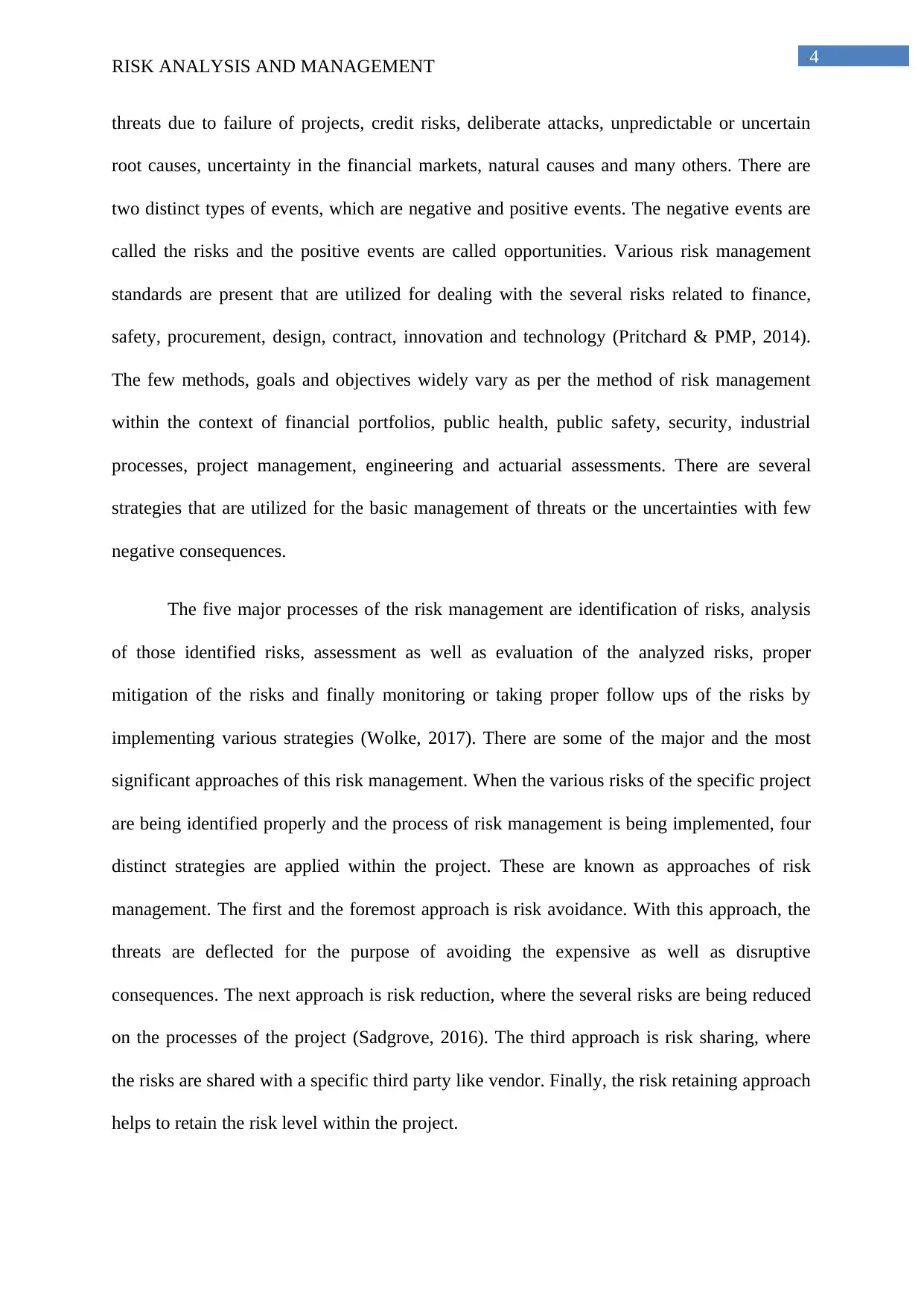
4
RISK ANALYSIS AND MANAGEMENT
threats due to failure of projects, credit risks, deliberate attacks, unpredictable or uncertain
root causes, uncertainty in the financial markets, natural causes and many others. There are
two distinct types of events, which are negative and positive events. The negative events are
called the risks and the positive events are called opportunities. Various risk management
standards are present that are utilized for dealing with the several risks related to finance,
safety, procurement, design, contract, innovation and technology (Pritchard & PMP, 2014).
The few methods, goals and objectives widely vary as per the method of risk management
within the context of financial portfolios, public health, public safety, security, industrial
processes, project management, engineering and actuarial assessments. There are several
strategies that are utilized for the basic management of threats or the uncertainties with few
negative consequences.
The five major processes of the risk management are identification of risks, analysis
of those identified risks, assessment as well as evaluation of the analyzed risks, proper
mitigation of the risks and finally monitoring or taking proper follow ups of the risks by
implementing various strategies (Wolke, 2017). There are some of the major and the most
significant approaches of this risk management. When the various risks of the specific project
are being identified properly and the process of risk management is being implemented, four
distinct strategies are applied within the project. These are known as approaches of risk
management. The first and the foremost approach is risk avoidance. With this approach, the
threats are deflected for the purpose of avoiding the expensive as well as disruptive
consequences. The next approach is risk reduction, where the several risks are being reduced
on the processes of the project (Sadgrove, 2016). The third approach is risk sharing, where
the risks are shared with a specific third party like vendor. Finally, the risk retaining approach
helps to retain the risk level within the project.
RISK ANALYSIS AND MANAGEMENT
threats due to failure of projects, credit risks, deliberate attacks, unpredictable or uncertain
root causes, uncertainty in the financial markets, natural causes and many others. There are
two distinct types of events, which are negative and positive events. The negative events are
called the risks and the positive events are called opportunities. Various risk management
standards are present that are utilized for dealing with the several risks related to finance,
safety, procurement, design, contract, innovation and technology (Pritchard & PMP, 2014).
The few methods, goals and objectives widely vary as per the method of risk management
within the context of financial portfolios, public health, public safety, security, industrial
processes, project management, engineering and actuarial assessments. There are several
strategies that are utilized for the basic management of threats or the uncertainties with few
negative consequences.
The five major processes of the risk management are identification of risks, analysis
of those identified risks, assessment as well as evaluation of the analyzed risks, proper
mitigation of the risks and finally monitoring or taking proper follow ups of the risks by
implementing various strategies (Wolke, 2017). There are some of the major and the most
significant approaches of this risk management. When the various risks of the specific project
are being identified properly and the process of risk management is being implemented, four
distinct strategies are applied within the project. These are known as approaches of risk
management. The first and the foremost approach is risk avoidance. With this approach, the
threats are deflected for the purpose of avoiding the expensive as well as disruptive
consequences. The next approach is risk reduction, where the several risks are being reduced
on the processes of the project (Sadgrove, 2016). The third approach is risk sharing, where
the risks are shared with a specific third party like vendor. Finally, the risk retaining approach
helps to retain the risk level within the project.
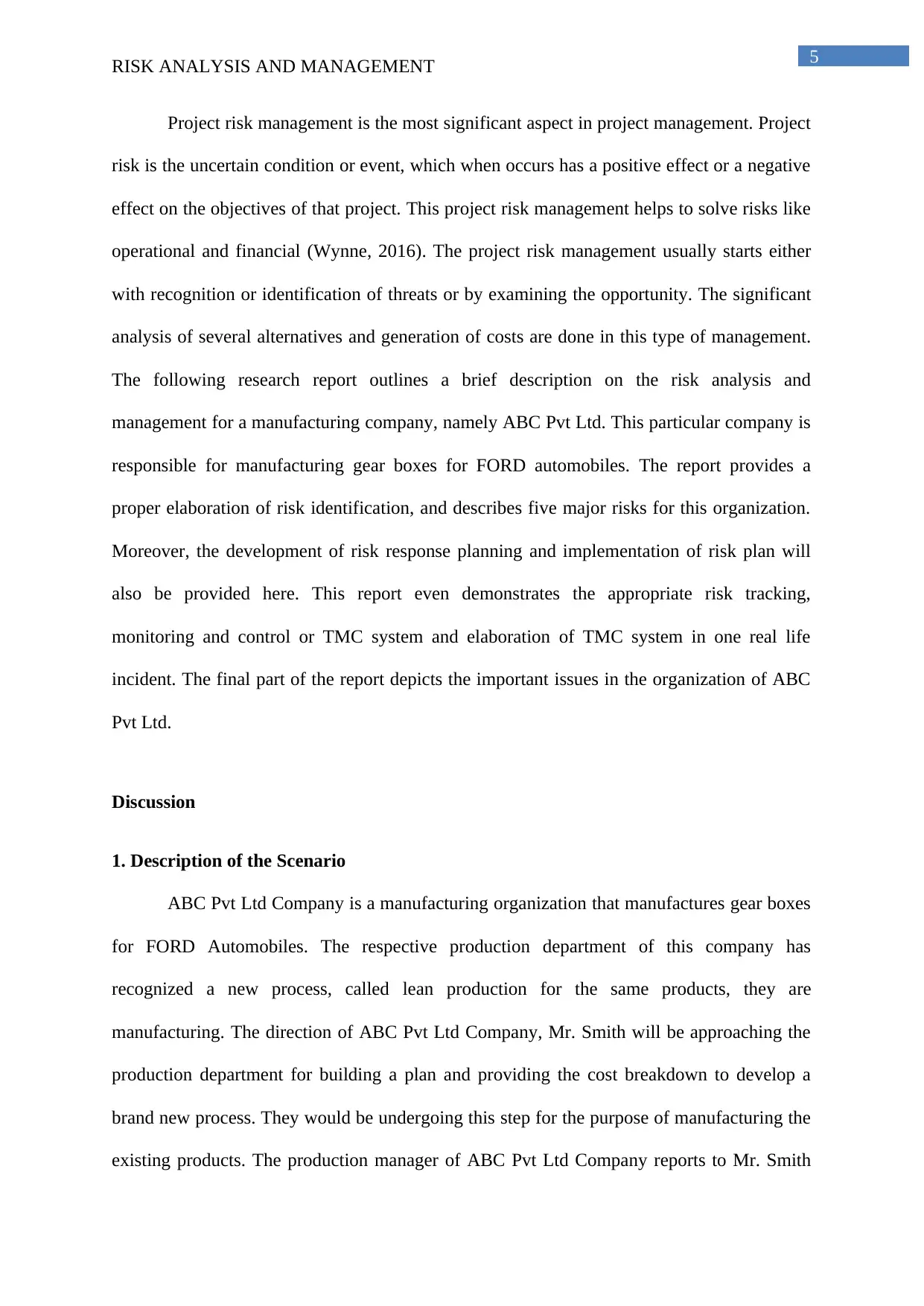
5
RISK ANALYSIS AND MANAGEMENT
Project risk management is the most significant aspect in project management. Project
risk is the uncertain condition or event, which when occurs has a positive effect or a negative
effect on the objectives of that project. This project risk management helps to solve risks like
operational and financial (Wynne, 2016). The project risk management usually starts either
with recognition or identification of threats or by examining the opportunity. The significant
analysis of several alternatives and generation of costs are done in this type of management.
The following research report outlines a brief description on the risk analysis and
management for a manufacturing company, namely ABC Pvt Ltd. This particular company is
responsible for manufacturing gear boxes for FORD automobiles. The report provides a
proper elaboration of risk identification, and describes five major risks for this organization.
Moreover, the development of risk response planning and implementation of risk plan will
also be provided here. This report even demonstrates the appropriate risk tracking,
monitoring and control or TMC system and elaboration of TMC system in one real life
incident. The final part of the report depicts the important issues in the organization of ABC
Pvt Ltd.
Discussion
1. Description of the Scenario
ABC Pvt Ltd Company is a manufacturing organization that manufactures gear boxes
for FORD Automobiles. The respective production department of this company has
recognized a new process, called lean production for the same products, they are
manufacturing. The direction of ABC Pvt Ltd Company, Mr. Smith will be approaching the
production department for building a plan and providing the cost breakdown to develop a
brand new process. They would be undergoing this step for the purpose of manufacturing the
existing products. The production manager of ABC Pvt Ltd Company reports to Mr. Smith
RISK ANALYSIS AND MANAGEMENT
Project risk management is the most significant aspect in project management. Project
risk is the uncertain condition or event, which when occurs has a positive effect or a negative
effect on the objectives of that project. This project risk management helps to solve risks like
operational and financial (Wynne, 2016). The project risk management usually starts either
with recognition or identification of threats or by examining the opportunity. The significant
analysis of several alternatives and generation of costs are done in this type of management.
The following research report outlines a brief description on the risk analysis and
management for a manufacturing company, namely ABC Pvt Ltd. This particular company is
responsible for manufacturing gear boxes for FORD automobiles. The report provides a
proper elaboration of risk identification, and describes five major risks for this organization.
Moreover, the development of risk response planning and implementation of risk plan will
also be provided here. This report even demonstrates the appropriate risk tracking,
monitoring and control or TMC system and elaboration of TMC system in one real life
incident. The final part of the report depicts the important issues in the organization of ABC
Pvt Ltd.
Discussion
1. Description of the Scenario
ABC Pvt Ltd Company is a manufacturing organization that manufactures gear boxes
for FORD Automobiles. The respective production department of this company has
recognized a new process, called lean production for the same products, they are
manufacturing. The direction of ABC Pvt Ltd Company, Mr. Smith will be approaching the
production department for building a plan and providing the cost breakdown to develop a
brand new process. They would be undergoing this step for the purpose of manufacturing the
existing products. The production manager of ABC Pvt Ltd Company reports to Mr. Smith
⊘ This is a preview!⊘
Do you want full access?
Subscribe today to unlock all pages.

Trusted by 1+ million students worldwide
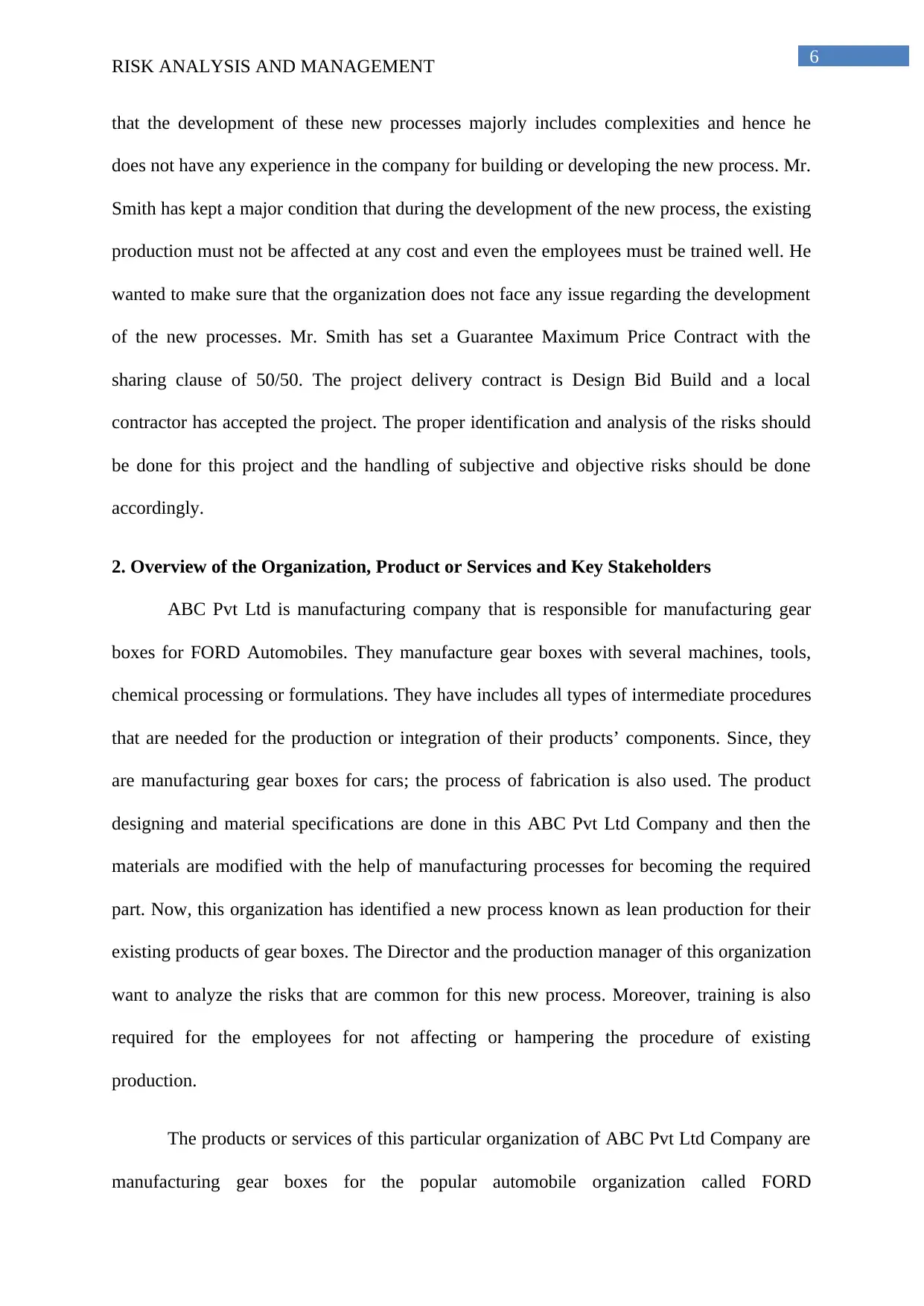
6
RISK ANALYSIS AND MANAGEMENT
that the development of these new processes majorly includes complexities and hence he
does not have any experience in the company for building or developing the new process. Mr.
Smith has kept a major condition that during the development of the new process, the existing
production must not be affected at any cost and even the employees must be trained well. He
wanted to make sure that the organization does not face any issue regarding the development
of the new processes. Mr. Smith has set a Guarantee Maximum Price Contract with the
sharing clause of 50/50. The project delivery contract is Design Bid Build and a local
contractor has accepted the project. The proper identification and analysis of the risks should
be done for this project and the handling of subjective and objective risks should be done
accordingly.
2. Overview of the Organization, Product or Services and Key Stakeholders
ABC Pvt Ltd is manufacturing company that is responsible for manufacturing gear
boxes for FORD Automobiles. They manufacture gear boxes with several machines, tools,
chemical processing or formulations. They have includes all types of intermediate procedures
that are needed for the production or integration of their products’ components. Since, they
are manufacturing gear boxes for cars; the process of fabrication is also used. The product
designing and material specifications are done in this ABC Pvt Ltd Company and then the
materials are modified with the help of manufacturing processes for becoming the required
part. Now, this organization has identified a new process known as lean production for their
existing products of gear boxes. The Director and the production manager of this organization
want to analyze the risks that are common for this new process. Moreover, training is also
required for the employees for not affecting or hampering the procedure of existing
production.
The products or services of this particular organization of ABC Pvt Ltd Company are
manufacturing gear boxes for the popular automobile organization called FORD
RISK ANALYSIS AND MANAGEMENT
that the development of these new processes majorly includes complexities and hence he
does not have any experience in the company for building or developing the new process. Mr.
Smith has kept a major condition that during the development of the new process, the existing
production must not be affected at any cost and even the employees must be trained well. He
wanted to make sure that the organization does not face any issue regarding the development
of the new processes. Mr. Smith has set a Guarantee Maximum Price Contract with the
sharing clause of 50/50. The project delivery contract is Design Bid Build and a local
contractor has accepted the project. The proper identification and analysis of the risks should
be done for this project and the handling of subjective and objective risks should be done
accordingly.
2. Overview of the Organization, Product or Services and Key Stakeholders
ABC Pvt Ltd is manufacturing company that is responsible for manufacturing gear
boxes for FORD Automobiles. They manufacture gear boxes with several machines, tools,
chemical processing or formulations. They have includes all types of intermediate procedures
that are needed for the production or integration of their products’ components. Since, they
are manufacturing gear boxes for cars; the process of fabrication is also used. The product
designing and material specifications are done in this ABC Pvt Ltd Company and then the
materials are modified with the help of manufacturing processes for becoming the required
part. Now, this organization has identified a new process known as lean production for their
existing products of gear boxes. The Director and the production manager of this organization
want to analyze the risks that are common for this new process. Moreover, training is also
required for the employees for not affecting or hampering the procedure of existing
production.
The products or services of this particular organization of ABC Pvt Ltd Company are
manufacturing gear boxes for the popular automobile organization called FORD
Paraphrase This Document
Need a fresh take? Get an instant paraphrase of this document with our AI Paraphraser
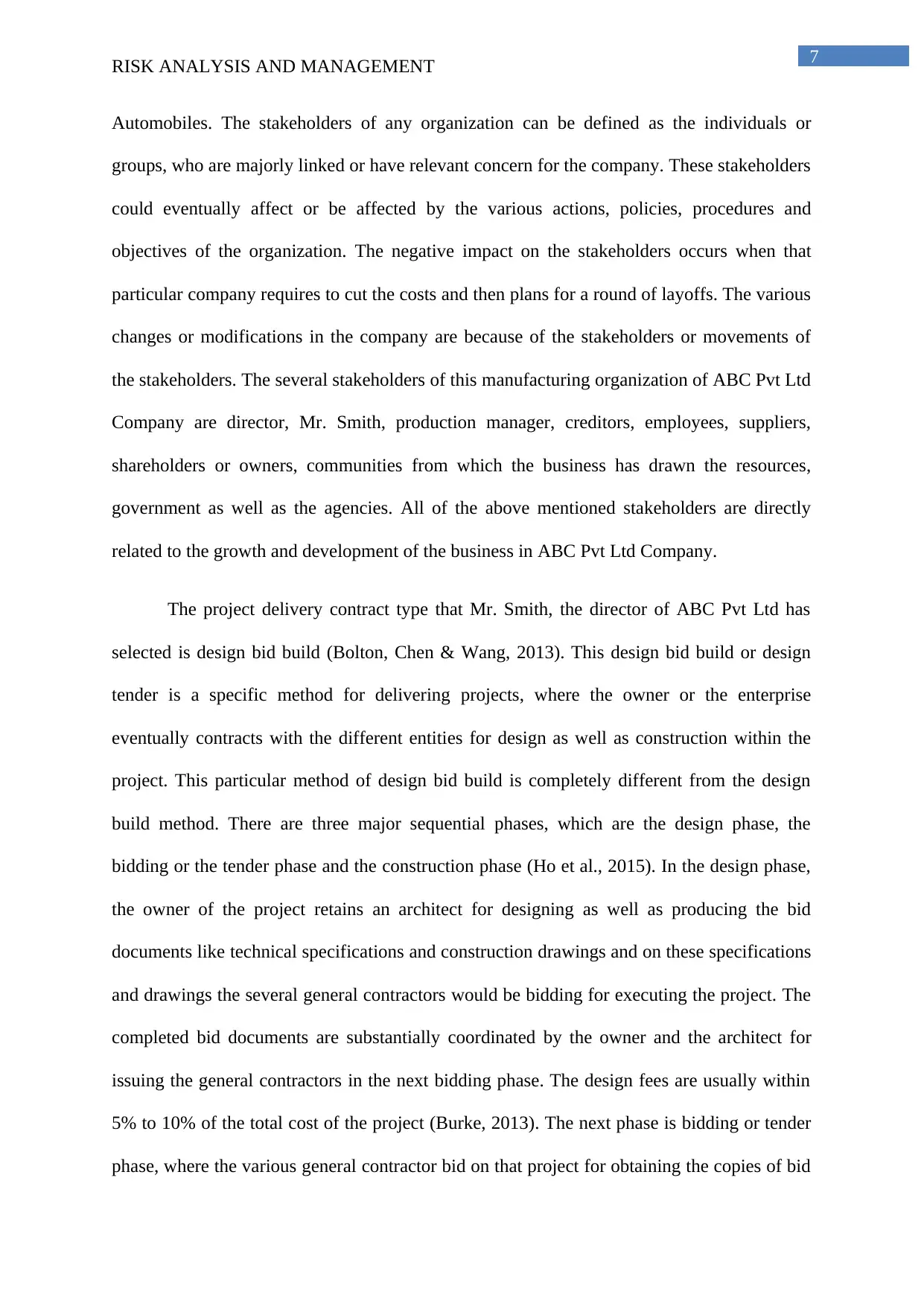
7
RISK ANALYSIS AND MANAGEMENT
Automobiles. The stakeholders of any organization can be defined as the individuals or
groups, who are majorly linked or have relevant concern for the company. These stakeholders
could eventually affect or be affected by the various actions, policies, procedures and
objectives of the organization. The negative impact on the stakeholders occurs when that
particular company requires to cut the costs and then plans for a round of layoffs. The various
changes or modifications in the company are because of the stakeholders or movements of
the stakeholders. The several stakeholders of this manufacturing organization of ABC Pvt Ltd
Company are director, Mr. Smith, production manager, creditors, employees, suppliers,
shareholders or owners, communities from which the business has drawn the resources,
government as well as the agencies. All of the above mentioned stakeholders are directly
related to the growth and development of the business in ABC Pvt Ltd Company.
The project delivery contract type that Mr. Smith, the director of ABC Pvt Ltd has
selected is design bid build (Bolton, Chen & Wang, 2013). This design bid build or design
tender is a specific method for delivering projects, where the owner or the enterprise
eventually contracts with the different entities for design as well as construction within the
project. This particular method of design bid build is completely different from the design
build method. There are three major sequential phases, which are the design phase, the
bidding or the tender phase and the construction phase (Ho et al., 2015). In the design phase,
the owner of the project retains an architect for designing as well as producing the bid
documents like technical specifications and construction drawings and on these specifications
and drawings the several general contractors would be bidding for executing the project. The
completed bid documents are substantially coordinated by the owner and the architect for
issuing the general contractors in the next bidding phase. The design fees are usually within
5% to 10% of the total cost of the project (Burke, 2013). The next phase is bidding or tender
phase, where the various general contractor bid on that project for obtaining the copies of bid
RISK ANALYSIS AND MANAGEMENT
Automobiles. The stakeholders of any organization can be defined as the individuals or
groups, who are majorly linked or have relevant concern for the company. These stakeholders
could eventually affect or be affected by the various actions, policies, procedures and
objectives of the organization. The negative impact on the stakeholders occurs when that
particular company requires to cut the costs and then plans for a round of layoffs. The various
changes or modifications in the company are because of the stakeholders or movements of
the stakeholders. The several stakeholders of this manufacturing organization of ABC Pvt Ltd
Company are director, Mr. Smith, production manager, creditors, employees, suppliers,
shareholders or owners, communities from which the business has drawn the resources,
government as well as the agencies. All of the above mentioned stakeholders are directly
related to the growth and development of the business in ABC Pvt Ltd Company.
The project delivery contract type that Mr. Smith, the director of ABC Pvt Ltd has
selected is design bid build (Bolton, Chen & Wang, 2013). This design bid build or design
tender is a specific method for delivering projects, where the owner or the enterprise
eventually contracts with the different entities for design as well as construction within the
project. This particular method of design bid build is completely different from the design
build method. There are three major sequential phases, which are the design phase, the
bidding or the tender phase and the construction phase (Ho et al., 2015). In the design phase,
the owner of the project retains an architect for designing as well as producing the bid
documents like technical specifications and construction drawings and on these specifications
and drawings the several general contractors would be bidding for executing the project. The
completed bid documents are substantially coordinated by the owner and the architect for
issuing the general contractors in the next bidding phase. The design fees are usually within
5% to 10% of the total cost of the project (Burke, 2013). The next phase is bidding or tender
phase, where the various general contractor bid on that project for obtaining the copies of bid
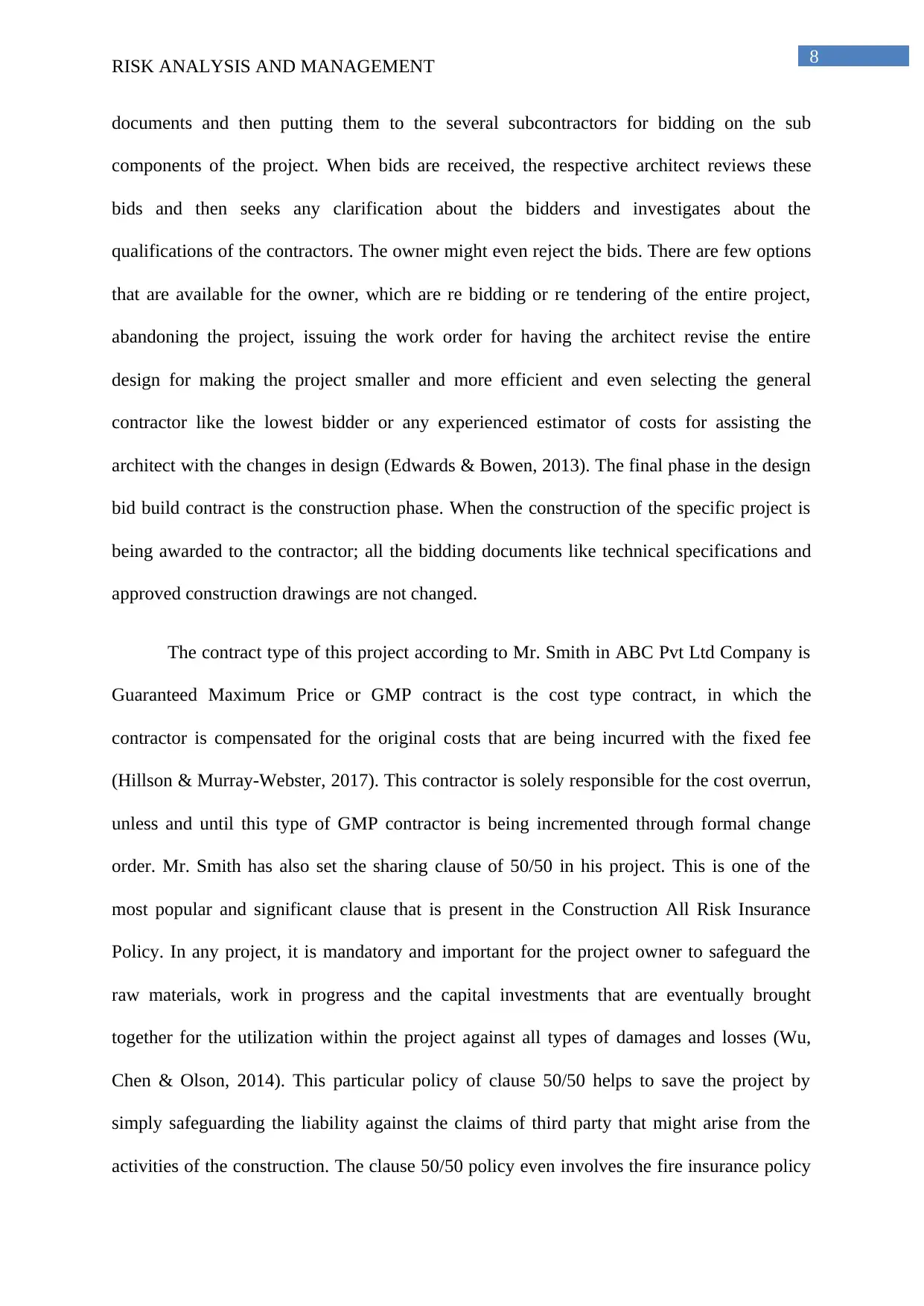
8
RISK ANALYSIS AND MANAGEMENT
documents and then putting them to the several subcontractors for bidding on the sub
components of the project. When bids are received, the respective architect reviews these
bids and then seeks any clarification about the bidders and investigates about the
qualifications of the contractors. The owner might even reject the bids. There are few options
that are available for the owner, which are re bidding or re tendering of the entire project,
abandoning the project, issuing the work order for having the architect revise the entire
design for making the project smaller and more efficient and even selecting the general
contractor like the lowest bidder or any experienced estimator of costs for assisting the
architect with the changes in design (Edwards & Bowen, 2013). The final phase in the design
bid build contract is the construction phase. When the construction of the specific project is
being awarded to the contractor; all the bidding documents like technical specifications and
approved construction drawings are not changed.
The contract type of this project according to Mr. Smith in ABC Pvt Ltd Company is
Guaranteed Maximum Price or GMP contract is the cost type contract, in which the
contractor is compensated for the original costs that are being incurred with the fixed fee
(Hillson & Murray-Webster, 2017). This contractor is solely responsible for the cost overrun,
unless and until this type of GMP contractor is being incremented through formal change
order. Mr. Smith has also set the sharing clause of 50/50 in his project. This is one of the
most popular and significant clause that is present in the Construction All Risk Insurance
Policy. In any project, it is mandatory and important for the project owner to safeguard the
raw materials, work in progress and the capital investments that are eventually brought
together for the utilization within the project against all types of damages and losses (Wu,
Chen & Olson, 2014). This particular policy of clause 50/50 helps to save the project by
simply safeguarding the liability against the claims of third party that might arise from the
activities of the construction. The clause 50/50 policy even involves the fire insurance policy
RISK ANALYSIS AND MANAGEMENT
documents and then putting them to the several subcontractors for bidding on the sub
components of the project. When bids are received, the respective architect reviews these
bids and then seeks any clarification about the bidders and investigates about the
qualifications of the contractors. The owner might even reject the bids. There are few options
that are available for the owner, which are re bidding or re tendering of the entire project,
abandoning the project, issuing the work order for having the architect revise the entire
design for making the project smaller and more efficient and even selecting the general
contractor like the lowest bidder or any experienced estimator of costs for assisting the
architect with the changes in design (Edwards & Bowen, 2013). The final phase in the design
bid build contract is the construction phase. When the construction of the specific project is
being awarded to the contractor; all the bidding documents like technical specifications and
approved construction drawings are not changed.
The contract type of this project according to Mr. Smith in ABC Pvt Ltd Company is
Guaranteed Maximum Price or GMP contract is the cost type contract, in which the
contractor is compensated for the original costs that are being incurred with the fixed fee
(Hillson & Murray-Webster, 2017). This contractor is solely responsible for the cost overrun,
unless and until this type of GMP contractor is being incremented through formal change
order. Mr. Smith has also set the sharing clause of 50/50 in his project. This is one of the
most popular and significant clause that is present in the Construction All Risk Insurance
Policy. In any project, it is mandatory and important for the project owner to safeguard the
raw materials, work in progress and the capital investments that are eventually brought
together for the utilization within the project against all types of damages and losses (Wu,
Chen & Olson, 2014). This particular policy of clause 50/50 helps to save the project by
simply safeguarding the liability against the claims of third party that might arise from the
activities of the construction. The clause 50/50 policy even involves the fire insurance policy
⊘ This is a preview!⊘
Do you want full access?
Subscribe today to unlock all pages.

Trusted by 1+ million students worldwide
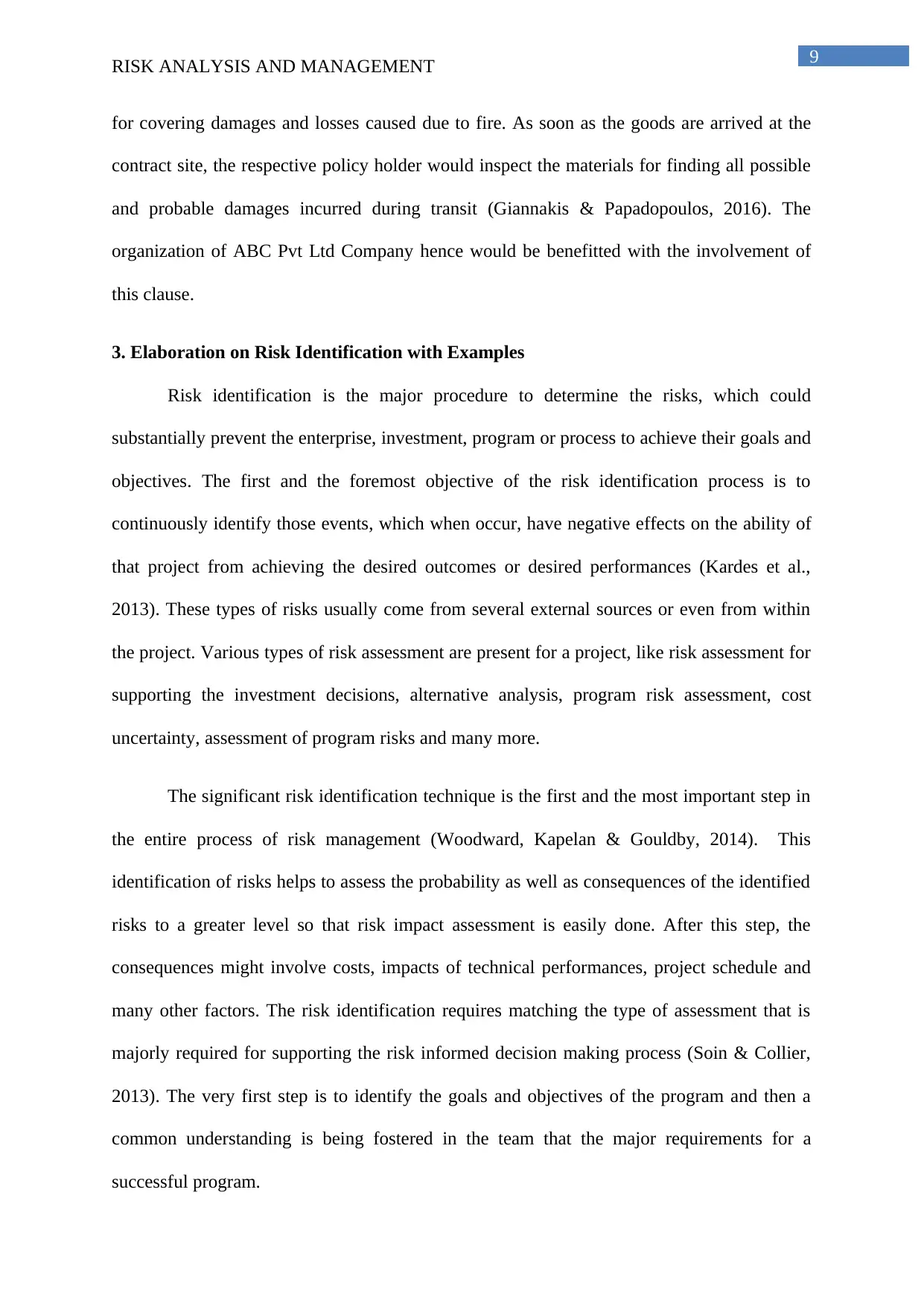
9
RISK ANALYSIS AND MANAGEMENT
for covering damages and losses caused due to fire. As soon as the goods are arrived at the
contract site, the respective policy holder would inspect the materials for finding all possible
and probable damages incurred during transit (Giannakis & Papadopoulos, 2016). The
organization of ABC Pvt Ltd Company hence would be benefitted with the involvement of
this clause.
3. Elaboration on Risk Identification with Examples
Risk identification is the major procedure to determine the risks, which could
substantially prevent the enterprise, investment, program or process to achieve their goals and
objectives. The first and the foremost objective of the risk identification process is to
continuously identify those events, which when occur, have negative effects on the ability of
that project from achieving the desired outcomes or desired performances (Kardes et al.,
2013). These types of risks usually come from several external sources or even from within
the project. Various types of risk assessment are present for a project, like risk assessment for
supporting the investment decisions, alternative analysis, program risk assessment, cost
uncertainty, assessment of program risks and many more.
The significant risk identification technique is the first and the most important step in
the entire process of risk management (Woodward, Kapelan & Gouldby, 2014). This
identification of risks helps to assess the probability as well as consequences of the identified
risks to a greater level so that risk impact assessment is easily done. After this step, the
consequences might involve costs, impacts of technical performances, project schedule and
many other factors. The risk identification requires matching the type of assessment that is
majorly required for supporting the risk informed decision making process (Soin & Collier,
2013). The very first step is to identify the goals and objectives of the program and then a
common understanding is being fostered in the team that the major requirements for a
successful program.
RISK ANALYSIS AND MANAGEMENT
for covering damages and losses caused due to fire. As soon as the goods are arrived at the
contract site, the respective policy holder would inspect the materials for finding all possible
and probable damages incurred during transit (Giannakis & Papadopoulos, 2016). The
organization of ABC Pvt Ltd Company hence would be benefitted with the involvement of
this clause.
3. Elaboration on Risk Identification with Examples
Risk identification is the major procedure to determine the risks, which could
substantially prevent the enterprise, investment, program or process to achieve their goals and
objectives. The first and the foremost objective of the risk identification process is to
continuously identify those events, which when occur, have negative effects on the ability of
that project from achieving the desired outcomes or desired performances (Kardes et al.,
2013). These types of risks usually come from several external sources or even from within
the project. Various types of risk assessment are present for a project, like risk assessment for
supporting the investment decisions, alternative analysis, program risk assessment, cost
uncertainty, assessment of program risks and many more.
The significant risk identification technique is the first and the most important step in
the entire process of risk management (Woodward, Kapelan & Gouldby, 2014). This
identification of risks helps to assess the probability as well as consequences of the identified
risks to a greater level so that risk impact assessment is easily done. After this step, the
consequences might involve costs, impacts of technical performances, project schedule and
many other factors. The risk identification requires matching the type of assessment that is
majorly required for supporting the risk informed decision making process (Soin & Collier,
2013). The very first step is to identify the goals and objectives of the program and then a
common understanding is being fostered in the team that the major requirements for a
successful program.
Paraphrase This Document
Need a fresh take? Get an instant paraphrase of this document with our AI Paraphraser
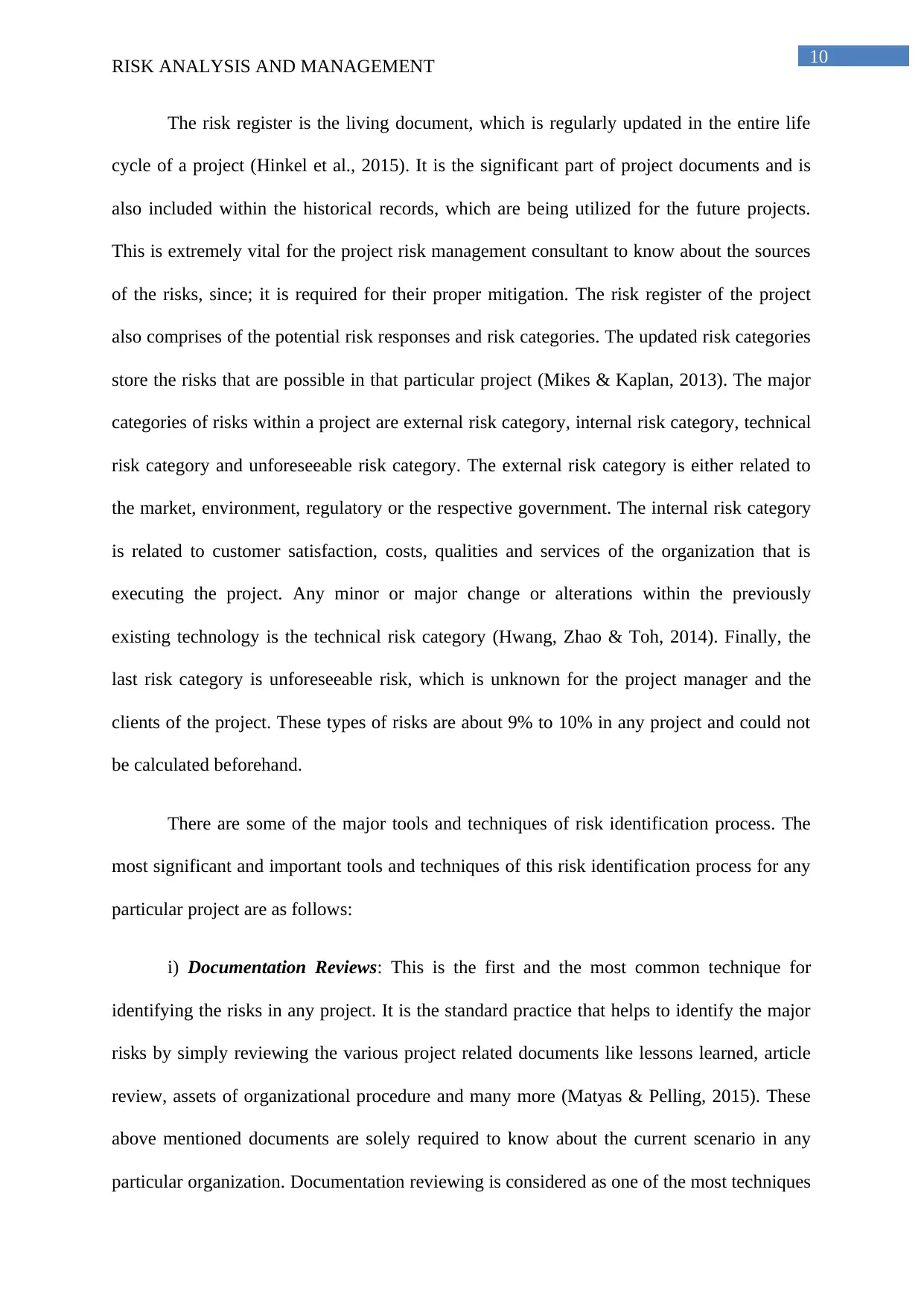
10
RISK ANALYSIS AND MANAGEMENT
The risk register is the living document, which is regularly updated in the entire life
cycle of a project (Hinkel et al., 2015). It is the significant part of project documents and is
also included within the historical records, which are being utilized for the future projects.
This is extremely vital for the project risk management consultant to know about the sources
of the risks, since; it is required for their proper mitigation. The risk register of the project
also comprises of the potential risk responses and risk categories. The updated risk categories
store the risks that are possible in that particular project (Mikes & Kaplan, 2013). The major
categories of risks within a project are external risk category, internal risk category, technical
risk category and unforeseeable risk category. The external risk category is either related to
the market, environment, regulatory or the respective government. The internal risk category
is related to customer satisfaction, costs, qualities and services of the organization that is
executing the project. Any minor or major change or alterations within the previously
existing technology is the technical risk category (Hwang, Zhao & Toh, 2014). Finally, the
last risk category is unforeseeable risk, which is unknown for the project manager and the
clients of the project. These types of risks are about 9% to 10% in any project and could not
be calculated beforehand.
There are some of the major tools and techniques of risk identification process. The
most significant and important tools and techniques of this risk identification process for any
particular project are as follows:
i) Documentation Reviews: This is the first and the most common technique for
identifying the risks in any project. It is the standard practice that helps to identify the major
risks by simply reviewing the various project related documents like lessons learned, article
review, assets of organizational procedure and many more (Matyas & Pelling, 2015). These
above mentioned documents are solely required to know about the current scenario in any
particular organization. Documentation reviewing is considered as one of the most techniques
RISK ANALYSIS AND MANAGEMENT
The risk register is the living document, which is regularly updated in the entire life
cycle of a project (Hinkel et al., 2015). It is the significant part of project documents and is
also included within the historical records, which are being utilized for the future projects.
This is extremely vital for the project risk management consultant to know about the sources
of the risks, since; it is required for their proper mitigation. The risk register of the project
also comprises of the potential risk responses and risk categories. The updated risk categories
store the risks that are possible in that particular project (Mikes & Kaplan, 2013). The major
categories of risks within a project are external risk category, internal risk category, technical
risk category and unforeseeable risk category. The external risk category is either related to
the market, environment, regulatory or the respective government. The internal risk category
is related to customer satisfaction, costs, qualities and services of the organization that is
executing the project. Any minor or major change or alterations within the previously
existing technology is the technical risk category (Hwang, Zhao & Toh, 2014). Finally, the
last risk category is unforeseeable risk, which is unknown for the project manager and the
clients of the project. These types of risks are about 9% to 10% in any project and could not
be calculated beforehand.
There are some of the major tools and techniques of risk identification process. The
most significant and important tools and techniques of this risk identification process for any
particular project are as follows:
i) Documentation Reviews: This is the first and the most common technique for
identifying the risks in any project. It is the standard practice that helps to identify the major
risks by simply reviewing the various project related documents like lessons learned, article
review, assets of organizational procedure and many more (Matyas & Pelling, 2015). These
above mentioned documents are solely required to know about the current scenario in any
particular organization. Documentation reviewing is considered as one of the most techniques
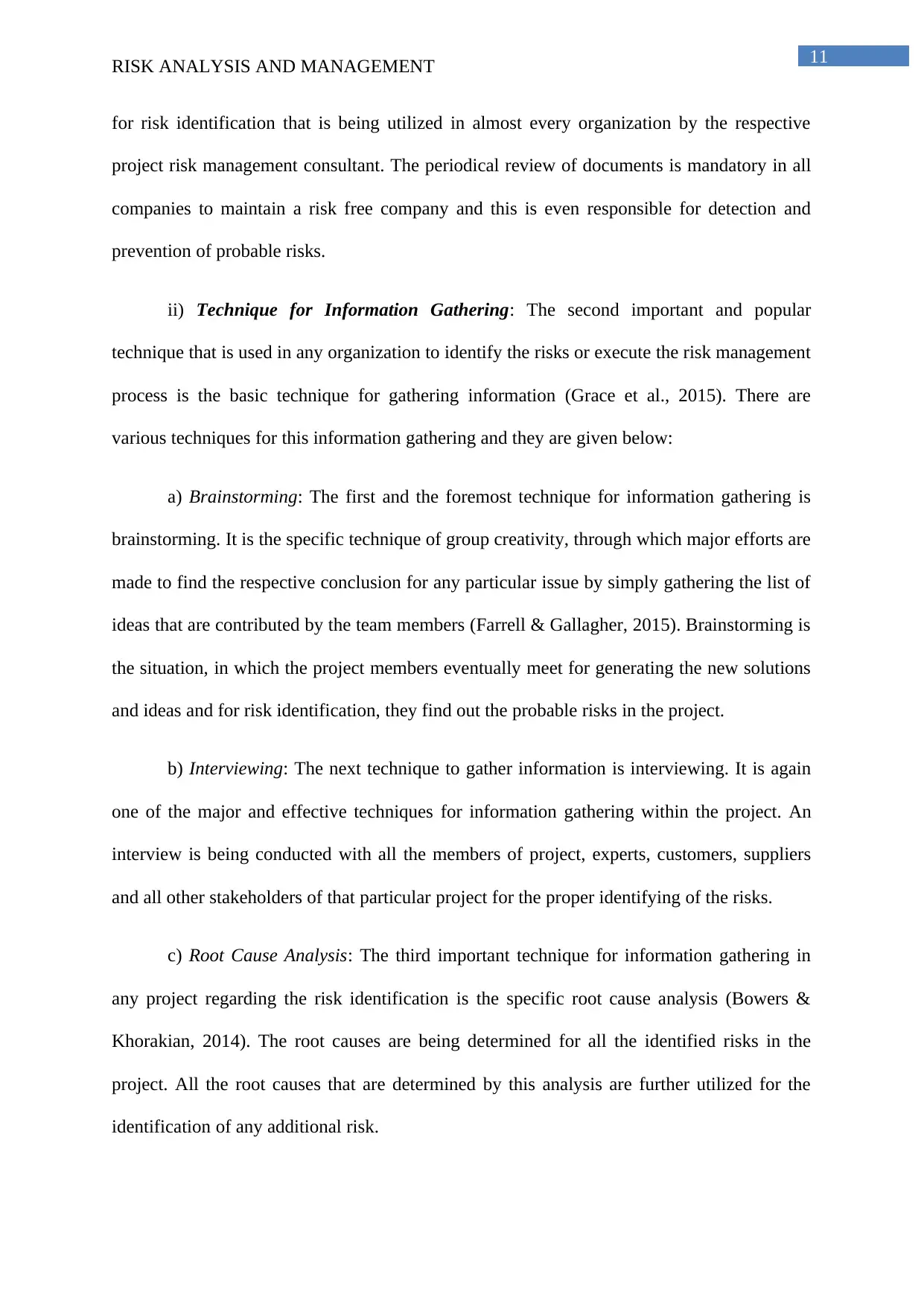
11
RISK ANALYSIS AND MANAGEMENT
for risk identification that is being utilized in almost every organization by the respective
project risk management consultant. The periodical review of documents is mandatory in all
companies to maintain a risk free company and this is even responsible for detection and
prevention of probable risks.
ii) Technique for Information Gathering: The second important and popular
technique that is used in any organization to identify the risks or execute the risk management
process is the basic technique for gathering information (Grace et al., 2015). There are
various techniques for this information gathering and they are given below:
a) Brainstorming: The first and the foremost technique for information gathering is
brainstorming. It is the specific technique of group creativity, through which major efforts are
made to find the respective conclusion for any particular issue by simply gathering the list of
ideas that are contributed by the team members (Farrell & Gallagher, 2015). Brainstorming is
the situation, in which the project members eventually meet for generating the new solutions
and ideas and for risk identification, they find out the probable risks in the project.
b) Interviewing: The next technique to gather information is interviewing. It is again
one of the major and effective techniques for information gathering within the project. An
interview is being conducted with all the members of project, experts, customers, suppliers
and all other stakeholders of that particular project for the proper identifying of the risks.
c) Root Cause Analysis: The third important technique for information gathering in
any project regarding the risk identification is the specific root cause analysis (Bowers &
Khorakian, 2014). The root causes are being determined for all the identified risks in the
project. All the root causes that are determined by this analysis are further utilized for the
identification of any additional risk.
RISK ANALYSIS AND MANAGEMENT
for risk identification that is being utilized in almost every organization by the respective
project risk management consultant. The periodical review of documents is mandatory in all
companies to maintain a risk free company and this is even responsible for detection and
prevention of probable risks.
ii) Technique for Information Gathering: The second important and popular
technique that is used in any organization to identify the risks or execute the risk management
process is the basic technique for gathering information (Grace et al., 2015). There are
various techniques for this information gathering and they are given below:
a) Brainstorming: The first and the foremost technique for information gathering is
brainstorming. It is the specific technique of group creativity, through which major efforts are
made to find the respective conclusion for any particular issue by simply gathering the list of
ideas that are contributed by the team members (Farrell & Gallagher, 2015). Brainstorming is
the situation, in which the project members eventually meet for generating the new solutions
and ideas and for risk identification, they find out the probable risks in the project.
b) Interviewing: The next technique to gather information is interviewing. It is again
one of the major and effective techniques for information gathering within the project. An
interview is being conducted with all the members of project, experts, customers, suppliers
and all other stakeholders of that particular project for the proper identifying of the risks.
c) Root Cause Analysis: The third important technique for information gathering in
any project regarding the risk identification is the specific root cause analysis (Bowers &
Khorakian, 2014). The root causes are being determined for all the identified risks in the
project. All the root causes that are determined by this analysis are further utilized for the
identification of any additional risk.
⊘ This is a preview!⊘
Do you want full access?
Subscribe today to unlock all pages.

Trusted by 1+ million students worldwide
1 out of 46
Related Documents
Your All-in-One AI-Powered Toolkit for Academic Success.
+13062052269
info@desklib.com
Available 24*7 on WhatsApp / Email
![[object Object]](/_next/static/media/star-bottom.7253800d.svg)
Unlock your academic potential
Copyright © 2020–2025 A2Z Services. All Rights Reserved. Developed and managed by ZUCOL.





